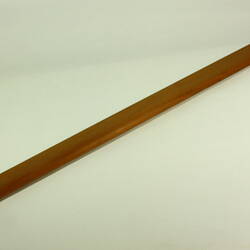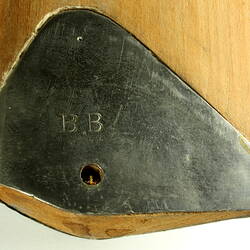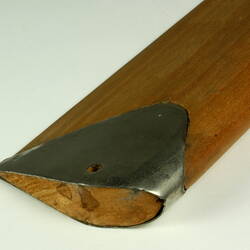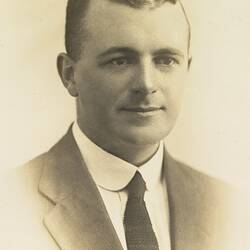Summary
Streamlined interplane wooden strut probably made from spruce. Associated with a Sopwith type single-seat biplane constructed by the donor's son, Basil Watson, in July-October 1916. The rib appears to be identical in design to struts visible in photographs of the completed plane such as (MM 143496), (MM 143498) and (MM 143499). It may be one of two similar struts that can be seen lying on the floor between the engine cowling and wooden saw horse in photograph (MM 143494).
Basil Watson was introduced to flying by Harry Hawker during an Australian publicity tour in early 1914, and subsequently travelled to England with Hawker, where he undertook flying lessons and worked as an engineer with the Sopwith Aviation Company. After the outbreak of WWI he was seconded to the British Government as a military test pilot, based at Brooklands aerodrome. He was severely injured in a crash after suffering an engine failure on take-off during a test flight in June 1915, and returned to Australia 12 months later, after being declared medically unfit for further military service. After constructing his own biplane from scratch at his parent's home in Elsternwick, in little more than 3 months, Watson piloted the aircraft on pioneering flights to Bendigo, western Victoria and Mount Gambier. He performed the first public aerial acrobatics flying demonstrations for crowds of spectators in Melbourne and country towns, and flew the first official airmail between Mt Gambier and Melbourne in February 1917. He was killed on 28th March 1917 when his aircraft crashed in shallow water in Port Phillip Bay, after a structural failure occurred as he performed an aerobatics display over Point Cook, Victoria. His death was the earliest recorded aviation fatality in Australia.
Presented to the Museum in 1919 by James Isaac Watson, father of Basil Watson, together with the Gnome aero engine, several spare parts and other items salvaged from the wreckage of the crashed aircraft. It is not known whether this strut was recovered from the actual plane or was a spare component.
Physical Description
Streamlined wooden strut with a aerofoil-shaped cross-section rounded at the front edge and tapering to a pointed or sharp trailing edge. Each end of the strut is wrapped in a triangular-shaped steel socket, which is designed to protect the timber and prevent splitting or enlargement around the attachment holes.
More Information
-
Collection Names
-
Collecting Areas
-
Acquisition Information
Donation from James I. Watson, 28 Oct 1919
-
Place Used
-
Inscriptions
'BB' and 'BT' stamped or impressed into metal sockets at either end of strut.
-
Classification
-
Category
-
Discipline
-
Type of item
-
Overall Dimensions
138 cm (Length)
-
Dimensions
137.5 cm (Length), 8.3 cm (Width), 2.2 cm (Height)
Measurement From Conservation. Measuring Method: flexible tape measure
-
Keywords
Aeroplane Components, Aircraft, Aircraft Manufacture, Aircraft Wings, Aviation, Aviation Pioneers, Biplanes









